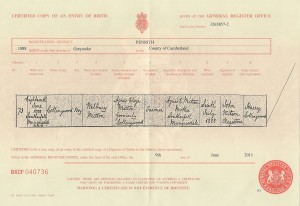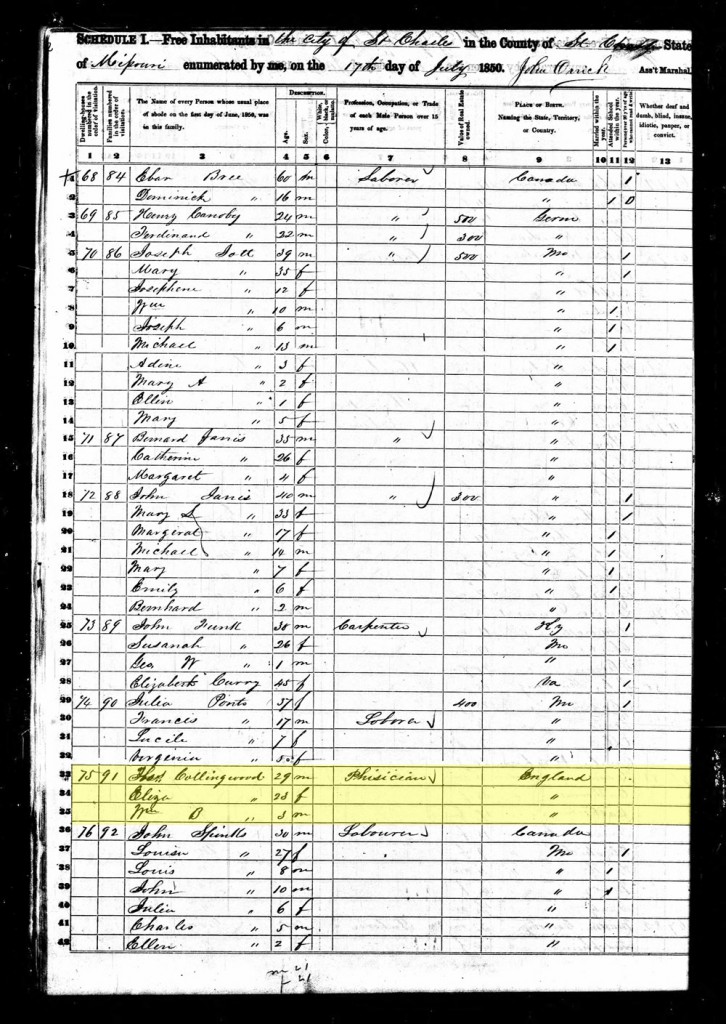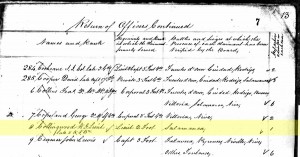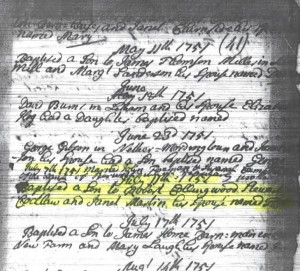Many members of my family share the middle name of Collingwood, including my great-uncle, two of his sons and one of his great-grandsons, as well as my great-grandfather. This name has in fact made researching my mother’s paternal family history relatively easy as although it is not hugely rare, it is by no means common either, especially as a middle name.

When I first started researching my ancestry nearly 5 years ago, I started with my mother’s grandfather, Harry Collingwood Mitton, as I knew the least about him. After learning of the other relatives that shared the same middle name, I wanted to find out if it originated from a family name and if so, learn more about the Collingwood family. Census records and Harry’s birth certificate confirmed that his parents were Welbury Mitton and Agnes Eliza Phoebe Collingwood. That was the first question answered: Collingwood was indeed a family name; my great-great-grandmother’s maiden name. I have read that it is a tradition for sons to be named after their mother’s (or a grandmother’s) maiden name and it was further evidenced by the fact that on his birth certificate, Harry was actually registered as just “Collingwood Mitton” and then later baptised as “Harry Collingwood Mitton”.
I now turned to Agnes’ line to find out where her family originated from. Agnes was born in 1852 in the small village of Ainstable in Cumberland, England. Her parents were Thomas Collingwood and Eliza Smith. The Smith family had long been in Ainstable, and although it is one of the most common surnames, the Smiths of Ainstable where fairly easy to track down. Thomas Collingwood’s life however, is still a bit of a mystery to me today. Thomas and Eliza married in Ainstable in 1847, where Thomas’ profession was listed as a Gentlemen. At first, this was the only documented trace of Thomas I had. Frustratingly, their marriage certificate only recorded Thomas’ age as “of full age”, so he was born in 1826 at the latest.

The first sign of Agnes in the censuses is in 1861 where she is living with her brother William and her mother Eliza in Ainstable. Eliza was listed as a widow. My attempts to track down Eliza and Thomas ten years earlier in 1851 proved futile, which made sense when I found a passenger list record of the couple, along with their young son William, leaving on a ship from Liverpool to New Orleans in the April of 1850. Thomas was listed as the onboard physician and he and his family were three of the very few cabin passengers. A couple of months later, in July 1850, the family could be found in the US 1850 census, living St Charles, Missouri, where Thomas was working as a physician. These documents finally gave me a date of birth for Thomas, 1821, yet the US census only lists his place of birth as England — not much help with tracking down a record of his baptism.

It is unclear what happenened to Thomas and Eliza in the period between 1850 and 1861. I know that their daughter Agnes was born in England on the 3rd October 1852, and that Eliza was widowed by 1861. My theory is that Thomas died in the United States, when Eliza was pregnant with Agnes, who then made her way back to England. Another theory is that they could have come back to England by 1852, and Thomas died some time between then and 1861. Agnes doesn’t list her father as deceased on her marriage certificate in 1873, but I’m pretty sure that fathers weren’t always recorded as deceased, even if they were. Plus, Eliza later had two more illegitimate children — Mary and Harry Collingwood, in 1866 and 1867 respectively.

Luckily my research into the Collingwoods didn’t hit a brick wall with Thomas. His marriage certificate gives his father’s name as William Dixon Collingwood, a name unique enough to make tracking him down fairly easy (although Thomas’ son also shared the name William Dixon Collingwood). Searching for records revealed that he was born in 1786 in Alnwick, Northumberland and married Phoebe Lovell, with whom he had three children: Eliza Elizabeth, William Cuthbert and Thomas. William died aged 65 in 1851 and is buried at St Michael’s Minster Church in Bishopwearmouth, although his burial plot has long since been built over. William was a Lieutenant (and possibly later a Captain) in the Northumberland Militia from 1804 until he retired in 1821. He fought in the Battle of Salamanca in 1812, during the Napoleonic Wars, an act that he received a medal for. William’s will reveals he owned shares in a ship — named The Marquess of Bute — with his brothers James and Robert, one that he and his family would frequently use to travel around the world: William’s son William Cuthbert was born in Halifax in Nova Scotia; his daughter Eliza emmigrated to Australia in the vessel; and his brother James Wilkie Collingwood was a Vice-Consul to Portugal.
William’s baptism reveals he was baptised on the 7th July 1786 at the Bridge Road Scotch Presbyterian Church in Monkwearmouth, Sunderland. His parents are listed as Thomas Collingwood and Elizabeth. Only one marriage existed for a Thomas Collingwood marrying a Elizabeth in the right time period and area, a marriage to an Elizabeth Forster in Warkworth, Northumberland in 1781. Tracking down more about this Thomas Collingwood revealed that he was a renowned surgeon in Sunderland, as well as undertaking a number of other pursuits, such as literature, arithmetic, horticulture and philosophy. I was lucky enough to stumble upon his seven-page obituary published in the “The Annual Biography and Obituary, Volume 7” published in 1823. This resource provided a huge amount of biographical and personal information about Dr Thomas’ character.

Thomas was born on the 7th July 1751 at Bates Cross, near Berwick-upon-Tweed, Northumberland. Bates Cross was so close to the border to Scotland, that the church he was baptised in was actually in Scotland. He studied at the University of Edinburgh and became a physician, settling in Northumberland: first at Norham, then in Alnwick, then finally in Sunderland. He married Elizabeth Forster, a member of another ancient Northumbrian family, with whom he had eight children with: George Forster, Robert Gustavus Adolphus, William Dixon, Athaliah, Matilda, Ralph, Catherine Eliza and James Wilkie Collingwood. His obituary states that his parents were Robert Collingwood and Elizabeth Martin (in certain records, such as Thomas’ baptism, she is recorded as Janet Martin), and he was the only son of six children. Thomas’ life was a fascinating one; predominently academic, but an inspiring one all the same. He was said to have never touched a drop of spirits and published a number of essays as well as a play, which I hope to get my hands on a copy of soon. Thomas died in 1822 and was also buried at St Michael’s Minster Church in Bishopwearmouth (later alongside his son William Dixon) although again, his burial plot has long since been built over.
Over a year ago now, I got in contact with Michael Bute, a biographer of Lewis Carroll. The Alice in Wonderland author, lesser known as Charles Lutwidge Dodgson, has a strong connection to the Collingwood family. His sister, Mary Charlotte Dodgson, married Charles Edward Stuart (C.E.S.) Collingwood, the son of the aforementioned James Wilkie Collingwood. Charles and Mary’s son Stuart Dodgson Collingwood became Lewis Carroll’s first biographer. Michael had some background knowledge of the Collingwood family and replied to a message board post I had published. With his help and his access to resources at the Northumberland Archives, I have managed to trace back the Collingwood line (as well as the Forster line) a very, very long way.
Without going into two much detail of individuals, by using pedigree charts and entries in publications such as Burke’s Landed Gentry, I can trace through generations of the paternal Collingwood line — specifically the Collingwood of Great Ryle, the Collingwood of Little Ryle, and eventually the Collingwood of Eslington lines — back to Robert Collingwood born in 1435, my 17x-great-grandfather.
Edit (June 2016): I have since realised that Dr Thomas Collingwood’s father Robert was not the son of Alexander Collingwood of Little Ryle. I believe there is still a link with the Collingwoods of Eslington but I am yet to find out where everything fits in.
Many of my distant Northumbrian Collingwood relatives were Knights, some were even High Sheriffs of Northumberland, and one, Sir Cuthbert Collingwood, was “the renowned border chieftain, who distinguised himself so much in the border wars of the sixteenth century”, and was mentioned as an ancestor of Dr Thomas in his obituary, but I believe this fact to be a mistake. Probably the most famous Collingwood was Vice Admiral Cuthbert Collingwood, known for being Horatio Nelson’s second-in-command, was a direct descendant of the border chieftain, Sir Cuthbert, but one of my direct ancestors was a cousin of this Sir Cuthbert, not a descendant. All in all, that makes me a 9th cousin, many many times removed, to the Admiral. Not as closely related as I had hoped, but related all the same. Its obvious the Admiral and his career were something his distant relatives were proud of, as frequently the names Cuthbert and Horatio appear as christian and middle names of their children.
I find the fact that the root of some living relatives’ names can be found with 15th century landed gentry individuals is truly amazing. I was quite lucky that the Collingwood family was an established Northumbrian family and that these records exist in such detail. If only I had the same resources available for all my other research lines. Using the Collingwood name as a middle name is a family tradition I plan on continuing one day with my own children.